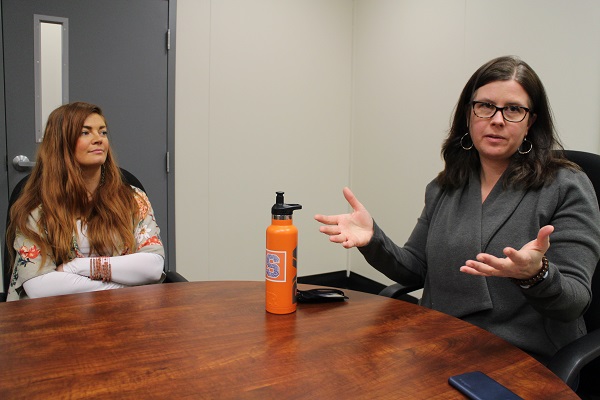
City Council members Stephanie Lynch, left, and Kristen Larson discuss their votes against Navy Hill and plans for moving forward. (Photos by Jonathan Spiers)
Note: This story has been updated with additional comments from the transcript to clarify Stephanie Lynch’s remarks about the project’s community benefits. The comments had been edited due to story length.
It was a month ago this week that the biggest economic development proposal in the history of Richmond was stopped in its tracks by a divided vote of City Council, bringing an end to the $1.5 billion project known as Navy Hill.
By all accounts, the redevelopment project that would have replaced the Richmond Coliseum and invigorated other city-owned land beside it is in fact dead, as Mayor Levar Stoney declared in a Q&A with BizSense in the week that followed the vote.
In the time since, council has pressed forward with the first steps of a plan to solicit more community input, appraise the land and put out a new request for proposals to revitalize the area – with or without a new arena.
The city also has received an offer from another developer proposing an alternate project that it says would not require a public funding component, as Navy Hill had through a proposed tax-increment financing (TIF) district that the council majority cited in their votes to kill the project.
BizSense sat down with two of those councilmembers – Kristen Larson of the Fourth District and Stephanie Lynch of the Fifth District – to discuss the reasons behind their votes, their thoughts on the project and process in retrospect, and how they see the city moving forward with the site. The following is an edited transcript:
Richmond BizSense: Kristen, you mentioned while we were sitting down for this interview a sense of relief that Navy Hill is behind you. Having led the push to vote it down, is there also a sense of accomplishment?
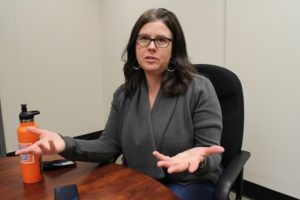
“There was a point in the process where I felt like we couldn’t continue down this path.” – Kristen Larson.
Larson: I don’t know if it was so much a feeling of accomplishment, but I think there was a point in the process where I felt like we couldn’t continue down this path, because from my perspective, I didn’t feel like there were amendments that could be made to fix it in a way that made the deal palatable for me to vote for it.
We had invested a ton of time and resources, so you do get to a point in the legislative process where you need to decide, are we going to continue to invest all these hours, all these resources, all these staff folks, me investing my time with constituents on this topic? Or are we going to say, “Hey guys, we can’t work with this plan anymore, it’s time to hit the reset button.” That’s where I got to, and that’s why I put my name on the resolution.
RBS: Stephanie, you campaigned (in a special election last fall to fill Parker Agelasto’s former seat) on a promise to vote against the project. What had made up your mind even before becoming an active council member and talking with the parties involved?
Lynch: Everyone in that race did, all eight of us. It was not something I ran on; it was something that I had to talk about, because it was one of the top three building issues in my district as the election and this Navy Hill deal came to a boil.
There were three things that I found to be egregious about the deal. Of course, the 80-block TIF, which would have held hostage 80 square blocks of downtown for the foreseeable future, 30-35 years, was I think in some ways running contrary to the promises that we had made citizens, which were: fix our schools first. Fixing our schools should be our No. 1 economic development priority. Why? Because our higher-income earners leave this city when their kids hit middle school, and we don’t get their taxes back.
Secondly, I think some of the community benefits that were being touted in this deal were hard for me to swallow, and some of the hope that was being sold that this was a project that was going to solve affordable housing in Richmond, it was going to solve poverty for the African-American community. It was a very dangerous line, and for me as a former social worker, was offensive to some of the communities that I had worked with and served in my previous role, to tout this project as a solvent for all of Richmond’s social ills, when in fact it was an economic development deal that likely would have accelerated the gentrification of this city.
The third piece that to me just didn’t make sense was the fact that we were putting up $600 million over the lifetime of 30 years, that’s three generations of schoolchildren, for a brand-new shiny 17,500-seat arena that’s 2,000 seats shy of Madison Square Garden. I don’t know that that was necessarily thought through. But possibly more ostentatious of a situation is the fact that no one bothered to ask the citizens of Richmond, “Hey, we’re putting up this much public funding; do you guys want a brand-new shiny 17,500-seat arena?”
RBS: There was an argument out there at the time of the vote that it sends a bad message to businesses looking to invest in Richmond.
Lynch: I think that was a message of convenience that served to justify this deal and this proposal. There was a huge grassroots advocacy effort through the small business community, through the corporate business community, and they were used and leveraged to believe that this proposal equated to the economic success of Richmond, which was false.
I will tell you now that Richmond is open for business, we are a City Council that wants to grow, that understands the importance of economic development, that wants to complete and succeed in the core functions of our local government through economic development. But to say that by saying no to this deal we’re saying no to business, that’s a false dichotomy, and quite frankly it’s a terrible message for anyone in our city to promote.
RBS: The ordinance spells out what steps you want taken, but what do you want to see in terms of a timeframe for this new RFP process?
Larson: I think there is a sense of the sooner the better, and the council president asked numerous times for the administration to put together a timeline. The two most immediate things are the appraisal and the community meetings. I suggested, and we talk about it in our resolution, using Richmond 300, because this portion of the city was left out of the Richmond 300 master plan planning process.
They already have the setup, the tools in place to do these outreach meetings, so I don’t see any reason why they can’t immediately put this on their schedule and push those meetings out over the next four or five weeks and get folks’ input and be able to break it down in a way that incorporates it into that plan. And at the same time, we can be doing those appraisals and finding out the value of that land.
RBS: Do you feel that the Navy Hill saga essentially provided that feedback and input from the community? What more needs to be said?
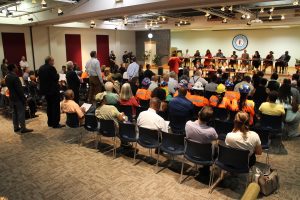
Council held a hearing last year on whether to put Navy Hill to voters through a referendum. (BizSense file)
Larson: Yes, through the public input and everything, I think we have gotten a lot of that. I don’t think we need six months of meetings; I think we need a couple meetings just to codify it and make sure it’s in a way that we’re all looking at the same thing.
Lynch: And it boils back down to that main question: do we want to be an arena city or not? Particularly if we are looking at a bright new shiny arena, we are going to be hard-pressed to find a developer that’s just going to hand over that investment without some kind of public subsidy.
As you are aware, we have received an unsolicited bid, which calls for the retrofitting and rehab of our current Coliseum, that involves absolutely no public subsidy whatsoever. But if the public decides they want a brand-new shiny arena, then it’s likely that we will have to do some type of subsidy for that. But that question has to be asked of the public first.
RBS: You mentioned Douglas Development’s offer. What are your initial thoughts on it, or are you waiting for it to go through the RFP process?
Larson: My understanding is that an unsolicited offer triggers the RFP process, because it opens the door and allows other bids to come in. I think that coming in two weeks after the vote shows that the development community has not been scared away and there are folks out there that are interested.

Dominion Energy CEO Tom Farrell of NH District Corp. discussing the project last year. (BizSense file photo)
I do think that folks realize that the first RFP that was put out there was very narrowly written and the timeframe was really short for what they were asking for, so I think that putting an RFP out on the street that is much more open, allows folks ample time to respond to the requirements of the RFP, I think we’re going to see something different.
RBS: In our Q&A with Mayor Stoney after the vote, he said he needs council “to act in good faith” if the city is going to accomplish large-scale projects like Navy Hill. How did you read that?
Larson: Inferring that we weren’t acting in good faith, I always act in good faith. The reality was we had one proposal for an RFP, and while slight changes could have been made to that plan, the entire plan was built around this huge arena that was very expensive and being funded by taxpayer dollars.
From where I sit, I’ve worked through the process and I’ve read the documents and I participated in all the workshops and got all the information the same time I’m talking to my constituents, and all of that was in good faith. But it did get to a point where I was like, we cannot make this right. And the amounts we’re investing and the land that we’re giving away and the return on that investment, it does not make sense for me.
Lynch: The message that is out there to the business community, and I want to set this straight, is that we turned down $1 billion, that we turned down an arena, that we turned down the possibility to generate $1.1 billion of revenue that would have been generated from the businesses, and that we turned down $300 million of minority business enterprise. If you just have those four talking points out there, that does make us look like irresponsible oppositionists, and that’s what the majority of folks who didn’t look into the deal really thought, because that’s what was put out there in the media.
If you peel back the onion on that, what we actually turned down was holding ourselves hostage to 80 square blocks and an unforeseen return-on-investment timeline; we turned down a lot of question marks that still had not been determined on the interest rate on those bonds and the mechanics behind how those would be paid off.
I want folks to know that there was more behind this deal than what was put out in talking points in the media and by the Navy Hill development corps. I think this notion that we are a dysfunctional body, that we turned down economic development, is a false narrative that served a purpose, but it is not necessarily the facts or the truth.

City Council members Stephanie Lynch, left, and Kristen Larson discuss their votes against Navy Hill and plans for moving forward. (Photos by Jonathan Spiers)
Note: This story has been updated with additional comments from the transcript to clarify Stephanie Lynch’s remarks about the project’s community benefits. The comments had been edited due to story length.
It was a month ago this week that the biggest economic development proposal in the history of Richmond was stopped in its tracks by a divided vote of City Council, bringing an end to the $1.5 billion project known as Navy Hill.
By all accounts, the redevelopment project that would have replaced the Richmond Coliseum and invigorated other city-owned land beside it is in fact dead, as Mayor Levar Stoney declared in a Q&A with BizSense in the week that followed the vote.
In the time since, council has pressed forward with the first steps of a plan to solicit more community input, appraise the land and put out a new request for proposals to revitalize the area – with or without a new arena.
The city also has received an offer from another developer proposing an alternate project that it says would not require a public funding component, as Navy Hill had through a proposed tax-increment financing (TIF) district that the council majority cited in their votes to kill the project.
BizSense sat down with two of those councilmembers – Kristen Larson of the Fourth District and Stephanie Lynch of the Fifth District – to discuss the reasons behind their votes, their thoughts on the project and process in retrospect, and how they see the city moving forward with the site. The following is an edited transcript:
Richmond BizSense: Kristen, you mentioned while we were sitting down for this interview a sense of relief that Navy Hill is behind you. Having led the push to vote it down, is there also a sense of accomplishment?

“There was a point in the process where I felt like we couldn’t continue down this path.” – Kristen Larson.
Larson: I don’t know if it was so much a feeling of accomplishment, but I think there was a point in the process where I felt like we couldn’t continue down this path, because from my perspective, I didn’t feel like there were amendments that could be made to fix it in a way that made the deal palatable for me to vote for it.
We had invested a ton of time and resources, so you do get to a point in the legislative process where you need to decide, are we going to continue to invest all these hours, all these resources, all these staff folks, me investing my time with constituents on this topic? Or are we going to say, “Hey guys, we can’t work with this plan anymore, it’s time to hit the reset button.” That’s where I got to, and that’s why I put my name on the resolution.
RBS: Stephanie, you campaigned (in a special election last fall to fill Parker Agelasto’s former seat) on a promise to vote against the project. What had made up your mind even before becoming an active council member and talking with the parties involved?
Lynch: Everyone in that race did, all eight of us. It was not something I ran on; it was something that I had to talk about, because it was one of the top three building issues in my district as the election and this Navy Hill deal came to a boil.
There were three things that I found to be egregious about the deal. Of course, the 80-block TIF, which would have held hostage 80 square blocks of downtown for the foreseeable future, 30-35 years, was I think in some ways running contrary to the promises that we had made citizens, which were: fix our schools first. Fixing our schools should be our No. 1 economic development priority. Why? Because our higher-income earners leave this city when their kids hit middle school, and we don’t get their taxes back.
Secondly, I think some of the community benefits that were being touted in this deal were hard for me to swallow, and some of the hope that was being sold that this was a project that was going to solve affordable housing in Richmond, it was going to solve poverty for the African-American community. It was a very dangerous line, and for me as a former social worker, was offensive to some of the communities that I had worked with and served in my previous role, to tout this project as a solvent for all of Richmond’s social ills, when in fact it was an economic development deal that likely would have accelerated the gentrification of this city.
The third piece that to me just didn’t make sense was the fact that we were putting up $600 million over the lifetime of 30 years, that’s three generations of schoolchildren, for a brand-new shiny 17,500-seat arena that’s 2,000 seats shy of Madison Square Garden. I don’t know that that was necessarily thought through. But possibly more ostentatious of a situation is the fact that no one bothered to ask the citizens of Richmond, “Hey, we’re putting up this much public funding; do you guys want a brand-new shiny 17,500-seat arena?”
RBS: There was an argument out there at the time of the vote that it sends a bad message to businesses looking to invest in Richmond.
Lynch: I think that was a message of convenience that served to justify this deal and this proposal. There was a huge grassroots advocacy effort through the small business community, through the corporate business community, and they were used and leveraged to believe that this proposal equated to the economic success of Richmond, which was false.
I will tell you now that Richmond is open for business, we are a City Council that wants to grow, that understands the importance of economic development, that wants to complete and succeed in the core functions of our local government through economic development. But to say that by saying no to this deal we’re saying no to business, that’s a false dichotomy, and quite frankly it’s a terrible message for anyone in our city to promote.
RBS: The ordinance spells out what steps you want taken, but what do you want to see in terms of a timeframe for this new RFP process?
Larson: I think there is a sense of the sooner the better, and the council president asked numerous times for the administration to put together a timeline. The two most immediate things are the appraisal and the community meetings. I suggested, and we talk about it in our resolution, using Richmond 300, because this portion of the city was left out of the Richmond 300 master plan planning process.
They already have the setup, the tools in place to do these outreach meetings, so I don’t see any reason why they can’t immediately put this on their schedule and push those meetings out over the next four or five weeks and get folks’ input and be able to break it down in a way that incorporates it into that plan. And at the same time, we can be doing those appraisals and finding out the value of that land.
RBS: Do you feel that the Navy Hill saga essentially provided that feedback and input from the community? What more needs to be said?

Council held a hearing last year on whether to put Navy Hill to voters through a referendum. (BizSense file)
Larson: Yes, through the public input and everything, I think we have gotten a lot of that. I don’t think we need six months of meetings; I think we need a couple meetings just to codify it and make sure it’s in a way that we’re all looking at the same thing.
Lynch: And it boils back down to that main question: do we want to be an arena city or not? Particularly if we are looking at a bright new shiny arena, we are going to be hard-pressed to find a developer that’s just going to hand over that investment without some kind of public subsidy.
As you are aware, we have received an unsolicited bid, which calls for the retrofitting and rehab of our current Coliseum, that involves absolutely no public subsidy whatsoever. But if the public decides they want a brand-new shiny arena, then it’s likely that we will have to do some type of subsidy for that. But that question has to be asked of the public first.
RBS: You mentioned Douglas Development’s offer. What are your initial thoughts on it, or are you waiting for it to go through the RFP process?
Larson: My understanding is that an unsolicited offer triggers the RFP process, because it opens the door and allows other bids to come in. I think that coming in two weeks after the vote shows that the development community has not been scared away and there are folks out there that are interested.

Dominion Energy CEO Tom Farrell of NH District Corp. discussing the project last year. (BizSense file photo)
I do think that folks realize that the first RFP that was put out there was very narrowly written and the timeframe was really short for what they were asking for, so I think that putting an RFP out on the street that is much more open, allows folks ample time to respond to the requirements of the RFP, I think we’re going to see something different.
RBS: In our Q&A with Mayor Stoney after the vote, he said he needs council “to act in good faith” if the city is going to accomplish large-scale projects like Navy Hill. How did you read that?
Larson: Inferring that we weren’t acting in good faith, I always act in good faith. The reality was we had one proposal for an RFP, and while slight changes could have been made to that plan, the entire plan was built around this huge arena that was very expensive and being funded by taxpayer dollars.
From where I sit, I’ve worked through the process and I’ve read the documents and I participated in all the workshops and got all the information the same time I’m talking to my constituents, and all of that was in good faith. But it did get to a point where I was like, we cannot make this right. And the amounts we’re investing and the land that we’re giving away and the return on that investment, it does not make sense for me.
Lynch: The message that is out there to the business community, and I want to set this straight, is that we turned down $1 billion, that we turned down an arena, that we turned down the possibility to generate $1.1 billion of revenue that would have been generated from the businesses, and that we turned down $300 million of minority business enterprise. If you just have those four talking points out there, that does make us look like irresponsible oppositionists, and that’s what the majority of folks who didn’t look into the deal really thought, because that’s what was put out there in the media.
If you peel back the onion on that, what we actually turned down was holding ourselves hostage to 80 square blocks and an unforeseen return-on-investment timeline; we turned down a lot of question marks that still had not been determined on the interest rate on those bonds and the mechanics behind how those would be paid off.
I want folks to know that there was more behind this deal than what was put out in talking points in the media and by the Navy Hill development corps. I think this notion that we are a dysfunctional body, that we turned down economic development, is a false narrative that served a purpose, but it is not necessarily the facts or the truth.


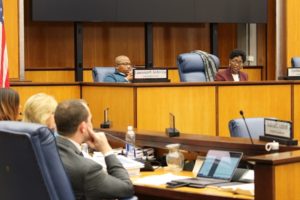
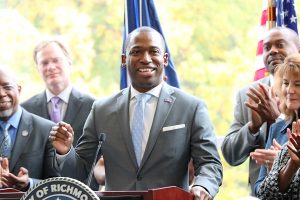


Lynch state s – “Fixing our schools should be our No. 1 economic development priority. Why? Because our higher-income earners leave this city when their kids hit middle school, and we don’t get their taxes back”. I would be curious to know how voting down the NH development is going to lead to “fixing our schools” or why both of those items are mutually exclusive? I would also be very curious if “fixing” includes new buildings or does she have another plan to fix issues like low test scores, a culture that doesn’t stress education, poor behavior among students (I… Read more »
>“Fixing our schools should be our No. 1 economic development priority. Why? Because our higher-income earners leave this city when their kids hit middle school, and we don’t get their taxes back”.
I wonder if she has data for this claim or is relying on anecdotes.
I hear today and I’ve heard for 25-years that Richmond must improve the schools. ” Fixing our schools should be our No. 1 economic development priority. Why? Because our higher-income earners leave this city when their kids hit middle school, and we don’t get their taxes back.” This statement and similar statements make good sound bits, but what is Ms. Lynch’s plan to succeed where the City has failed in the past. How about an outline at minimum?
Really glad to see BizSense investigate the rational actors of this vote. 2 years later, no one could explained how spending $300 million up front on an arena, and creating more generational debt, was able to fund Richmond schools. Arenas don’t magically create affordable housing either. All the pitched benefits Richmond was going to get were minuscule and weakly linked to a project no one was asking for. It was a used car salesman pitch at our front door, anchored by mafia-like strong-arm tactics. 5 council persons decided it was long past time to shut the door on the salesmen… Read more »
I will say this, the council members are task with an impossible agenda by their constituents. They want better schools, less crime, more economic activity, etc. etc. BUT without an increase in their home values and property taxes. If you fix all the “bad” things often associated with urban areas then yes economic development will pick up and people will want to live there and property values will skyrocket. It’s a simple supply and demand issue exasperated by the fact that cities are already fully “built out” so any new development involves buying very expensive land or buildings to rehab.… Read more »
It is clear from your comment, as with most people against navy hill, you only got information from other anti navy hill people who spread misinformation.
Affordable housing was guaranteed as part of the deal.
What isn’t going to magically happen is rent controlled apartments appearing in their own.
You are Wrong wrong wrong yet again, James. (1) The “Affordable housing” threshold was determined by the regional median income, not the city’s. So the “affordable” part was laughable and very misleading, at best for what Richmond actually needs. (2) The percentage of affordable units in the whole development also did not meet the legal requirement set out by council in ordinance last year. (3) The location of 80% of the “affordable” units weren’t even located in the Navy Hill neighborhood. So associating these with the development itself is also laughable and misleading. These can happen independent of Navy Hill… Read more »
The city is a famously awful place to do business, which is unrelated to Navy Hill. But they need to fix that
Hard for me to believe this comment could be voted down…
Stephanie Lynch’s cry-out that the first priority is to ” fix the schools first,” belies the fact that the two issues should be separated. The Navy Hill project would have replaced a functionally obsolete Coliseum. The half baked offer to renovate it won’t work simply because of the cost to do it, which hasn’t been fully vetted by the developer proposing it. Here’s what Navy Hill would have provided in addition to a replacement for the Coliseum: 1. Workforce apartments: Where are they going to come from now? 2. The long sought for bus transfer station. 3. The restoration of… Read more »
You forgot to include unicorns and rainbows.
This is the most complete list of actual fact-driven reasons why we should have moved forward with the project. The bottom line is the Colisum was functionally obsolete, no one could fix that. It’s a shame we let another opportunity slip through our fingers. History will not be kind to those on city council.
Brian Glass
Biz Sense needs to make it possible to see all of the downvote trolls on these discussions – This post, which is literally just a name, clearly shows there is a problem. I hereby commit that if I downvote any of your comments, I will offer an accompanying comment on why, rather than just take the easy, anonymous downvote option.
I voted for you Justin. Got your back.
Thanks Chris, that’s exactly the transparency i’m hoping for!
Relax. I think people were down voting it as a joke on Brian and how he messed up his comment by only leaving his name.
On the topic of good development ideas that don’t follow through, I hope the casino that will be fully funded by private investment doesn’t fall in this category. There’s really no excuse for a fully funded luxury resort and casino to be rejected by the community to replace run down buildings in an area that needs the improvement.
Navy hill failed because it was grossly misunderstood by the community and the historically awful track record the city has with fiscal management. Let’s not repeat the same mistakes on a simple decision.
“Fix the schools” by eliminating concentrated poverty in the east end. Anyone interested in seeing a real-life, failed social experiment, just go drive though Creighton Court, Gilpin Court, Mosby Court. Give these residents some help to move on, then tear down these things down.
Ly – I agree the large scale low income housing projects have been a complete failure. But I wonder what is the best alternative? In my opinion the best way to fix the problem would be to have a 5 or 10% low income portion of all new development projects but I would qualify the people who get those units to the people that have full time jobs, are law abiding, have kids performing good in school, etc. Those are most people most likely to be good neighbors and turn out to be a “success story”. I realize that would… Read more »
Roger, did you review potential renters based on kids’ grades? Did you evict them if they lost their jobs? How on earth could a publicly funded project do those things?
“I would qualify the people who get those units to the people that have full time jobs, are law abiding, have kids performing good in school, etc. ”
First off, I think you meant to say “performing well in school”.
I guess you don’t make the cut for the ” brand new and nice” furnishings.
I would imagine your policy of only helping people who are already doing well will have good results.
I think penalizing a family because a student gets a bad grade is lunacy – a kid has dyslexia, it goes undiagnosed because of any number of issues (the state of affordable healthcare for the very population segment this addresses being what it is in the US, and all) and suddenly he doesn’t’ deserve a home?
“Sorry Junior, your reading grade was too low, so we’re all being evicted.” Putting THAT kind of pressure on a kid in the third grade? Yeah. That’s a good idea.
A couple of clarifications. In no way did I think my opinion would be implemented due to PC concerns, I was just pointing out what I thought would be one way to successfully integrate low income people from the housing projects into the general population. That was in response to an earlier comment that said ““Fix the schools” by eliminating concentrated poverty in the east end. Anyone interested in seeing a real-life, failed social experiment, just go drive though Creighton Court, Gilpin Court, Mosby Court. Give these residents some help to move on, then tear down these things down” For… Read more »
This is the most sheltered, pearl clutching, NIMBY,living in a snowflake bowl opinion I have ever heard. When kids are going to school and they have to deal with one or both parents on drugs, no one they know having the ability to get a job, or people getting shot in the street they have to walk down to GET to school, language is the least troubling thing they are going to deal with. Could you please go watch Season 4 of “The Wire” before you post again? Some times, people are just victims of circumstance. And telling people to… Read more »
>I think there was a point in the process where I felt like we couldn’t continue down this path, because from my perspective, I didn’t feel like there were amendments that could be made to fix it in a way that made the deal palatable for me to vote for it. What was the point in the process? What were the sticking points that couldn’t be negotiated? What were the amendments that would’ve made the deal palatable and why weren’t they being accepted? At the council meeting where the resolution was passed to kill Navy Hill, being tired was a… Read more »
I don’t understand, after all this time spent on the creation of the plan behind closed doors, copious articles and information available online that you could research on this topic, you and many others are still confused about the process and who and who did not dictate the process. City Council was tired because it had enough of reviewing a top-down idea and process, crafted by the elite behind closed doors, that was not going to show any measurable changes from any new proposed ordinance. It was a constant waste and distraction of everyone’s time but the Navy Hill developers.… Read more »
I really believe that through negotiation The City could have shaped this deal into a win for the City. I am a residential Realtor and we negotiate contracts every single day that start out far apart. Often we create something that works well for both parties in the end. Bring me an offer for a Billion dollars on a listing and I promise I’ll see the job through. I definitely won’t drop several hundred thousand of my clients money for a consultant and then disregard the findings and throw up my hands. I’m NOT saying this was a good deal… Read more »
It really would be nice to see some sort of a proposal on the schools from those who said it’s the top priority. The clock is ticking.